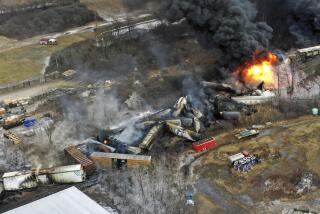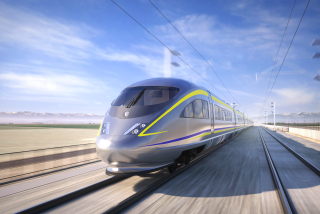Amtrak Gets Shot in Arm From Town Meetings : Transportation: Rail service support by farmers and small-town residents is credited with persuading Congress to scale back planned subsidy cuts.
- Share via
NEW YORK — Just a few weeks ago, Amtrak President and Chairman Thomas Downs thought Congress was ready to pull the plug on passenger rail.
After all, Amtrak, known formally as the National Railroad Passenger Corp., was losing money hand over fist and eating up almost $1 billion in federal subsidies every year.
That was before Amtrak held some town hall meetings. Out in the snow belt, farmers stepped up to the microphone and said Amtrak is crucial, that it’s the only thing moving in the winter. Small town residents from Vermont to Montana described train service as a lifeline.
“That reaction got back to Congress,” Downs told the Bloomberg Forum. “I think it changed a lot of attitudes.”
Also working in the railroad’s favor is a growing realization that closing Amtrak is costlier than keeping it. The reason: massive payouts to laid-off workers, debt service and other liabilities.
Now there’s little talk in Congress of “zeroing out” Amtrak’s federal subsidy. Downs, a former New Jersey transport chief who’s been tops at Amtrak since December, 1993, said he thinks Republican leaders in the House, in fact, are ready to keep the payout steady for the next few years. They’re even likely to cut some costly rules, he said.
It’s not all good news for Downs, though. Lawmakers are still likely to erase Amtrak’s federal operating subsidy--about $392 million a year--shortly after the turn of the century. And the Senate wants to chop this payment more quickly than the House, possibly starting in 1996 or 1997.
But Downs is hoping that all that outrage at the microphone will convince senators to go along with what is already happening in the House.
On May 26, the House transportation subcommittee on railroads voted to cut Amtrak’s total federal subsidy, currently $972 million a year, by just $60 million next year. And the bill would keep it at that level for 1997 and 1998 as well.
The full federal bill for Amtrak in the current fiscal year includes the operating subsidy plus $150 million for mandatory retirement payments, $230 million for capital investments and $200 million targeted for service in the busy Northeast corridor.
In 1999, still many budget battles away, the legislation would slash Amtrak’s total federal payout to $403 million. The full House Transportation Committee will vote on the package tomorrow.
It’s expected to endorse the spending numbers, at least. The final House figures won’t come, though, until the powerful Appropriations Committee has its say.
The House may add a further cost-saving provision along the way. This would let Amtrak slash the maximum severance pay due workers from six years to six months. Downs will get a read on the Senate’s views Friday when its transportation panel holds a hearing.
He has already slashed routes and cut jobs. There will be 4,000 fewer Amtrak jobs, in fact, at year’s end. Closing a $240-million budget deficit this year is the goal.
Amtrak says the cutbacks haven’t hurt business. Revenue in May ran ahead of the same month a year ago, before the cuts.
And Downs says the passenger railroad, owned partly by the federal government and partly by the freight railroads that coughed up the original equipment back in 1971, could even absorb a $130-million cut its operating subsidy next year--though Downs is not asking for it.
Capital investments are another matter, though. The railroad will always need federal money to upgrade track and rolling stock, Downs says. This isn’t unusual. France, Germany and Japan all subsidize passenger rail.
But Downs sees a day when, possibly, Amtrak could be split into two entities: an independent operating side, with shares possibly held by the public, and a capital-investment side funded by the federal government.
France has recently adopted this approach with its passenger rail system, and the British are considering doing the same.
Of course, this plan assumes that a substantial capital payout from the feds will continue.
*
Why does Amtrak need all those taxpayer dollars? Partly because passenger rail is unprofitable, no matter where you are. It needs too much big-time investment.
To this general complaint Amtrak adds further worries: bare-knuckle competition from cheap-ticket airlines and bus companies, and a reputation for late trains, accidents, and shabby service.
Another problem: costly protections for union jobs, and the refusal of lawmakers to let Amtrak chop money-losing routes.
The House bill addresses these problems. It would make it easier for Amtrak to scrap dog routes and hire outside help to do work more cheaply.
It also limits Amtrak’s liabilities and lets the railroad charge commuter lines more for using its Northeast track. Other features in the bill: continued funding for improvements in the Northeast, and money for a new Penn Station in New York City.
Downs says the bill illustrates a sea change in the debate. Instead of “zero out Amtrak,” he says, lawmakers are looking for ways to preserve the national network.
Amtrak, Downs says, “can’t just be the Northeast.”
More to Read
Get the L.A. Times Politics newsletter
Deeply reported insights into legislation, politics and policy from Sacramento, Washington and beyond. In your inbox three times per week.
You may occasionally receive promotional content from the Los Angeles Times.










